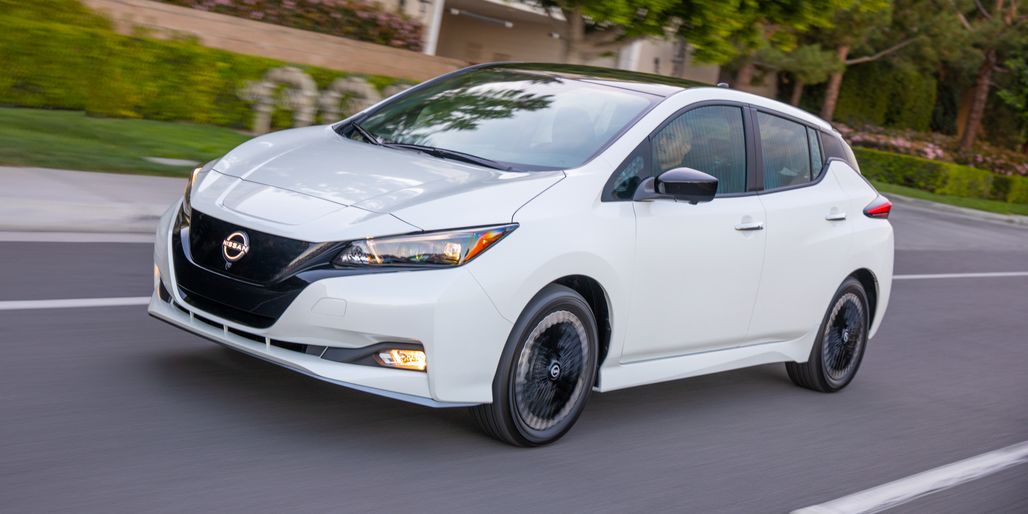2023 Nissan Leaf

Overview
The 2023 Nissan Leaf EV illustrates the difference between being attractive on paper and competitive in the real world. A starting price below $30,000 for any EV—this before any applicable tax credits—gets our attention. But, when compared to its rivals the Leaf’s driving range isn’t as good and its outdated charging technology makes it less user-friendly. The Leaf’s longest-range battery pack enables barely more than 200 miles of driving range; the Chevy Bolt EV, and the considerably more expensive Kia EV6 and Tesla Model 3 all beat that by a considerable margin. What’s more, not all public charging stations are compatible with the Nissan’s CHAdeMO charging connector. But if you’re someone who plans to drive only around town and can set up for charging at home, the Leaf might work—and it provides a low-cost point of entry into the world of EVs. It’s a small hatchback, which means it’s easy to thread through congested city traffic and find street parking for. Its cabin is spacious for a small car, comfortable, and nicely equipped with tech features. Unfortunately, the same can be said of several competitors, many of which offer more every-day usability, longer range, and access to more charging stations.
What’s New for 2023?
Nissan’s electric car receives a few styling improvements for 2023 including a revised grille, front bumper, and exterior lighting elements. A set of cool multi-spoke wheels and an illuminated Nissan badge round out the Leaf’s exterior changes. The lineup has been trimmed to just a base S model and the longer-range SV Plus.
Pricing and Which One to Buy
The best deal here is the SV Plus because it carries a reasonable price, the longest driving range, the more powerful electric motor, and offers a decent package of standard equipment. It has an 8.0-inch infotainment system with Apple CarPlay and Android Auto capability, automatic climate control, keyless entry with push-button start, and automatic headlamps.
EV Motor, Power, and Performance
Leafs are front-wheel drive cars. The standard Leaf S comes with a 147-horsepower electric motor and a 40.0-kWh battery pack—both dinky by today’s standards. Leaf SV Plus gets a gutsier, 214-hp electric motor and a larger 62.0-kWh battery. An S managed a 7.4-second zero-to-60-mph time at our test track, but it feels perkier than this number suggests thanks to the instantaneous power delivery of the electric motor. This result makes it slower than the Bolt EV and the Model 3, though. Upgrading to the more powerful Plus model will no doubt result in quicker acceleration, but we won’t be able to confirm that until we are able to test one. The Leaf’s e-Pedal feature allows the driver to toggle back and forth between regenerative braking modes, one of which allows the car to coast when the driver lifts off the throttle and another that slows the car when you take your foot off the gas and uses that energy to recharge the battery.
More on the Leaf Hatchback
Range, Charging, and Battery Life
The Leaf can be plugged in to a regular 120-volt outlet or a 240-volt outlet, but the charging times vary dramatically between the two. On a 240-volt connection, Nissan says both the standard Leaf’s battery and the larger one in the Leaf Plus can be replenished in seven hours. A DC fast-charging connection is standard on all trims. The Leaf S comes with a 40.0-kWh battery that provides a relatively limited range of 149 miles. This might be enough range for some drivers with short commutes but it’s less than half of what the Model 3’s Long Range model provides. The SV Plus provides 215 miles of EPA-rated driving range thanks to its larger battery pack.
Fuel Economy and Real-World MPGe
Our SV Plus test vehicle exceeded its EPA highway rating of 94 MPGe by delivering 98 MPGe over our 75-mph highway fuel-economy test route. However, we saw 180 miles of range during this test; EVs generally get less than their EPA rated number on the highway. For more information about the Leaf’s fuel economy, visit the EPA’s website.
Interior, Comfort, and Cargo
Although the cabin of the Leaf has a lot of black plastic, the well-assembled and uniform textures help it avoid looking cheap. The gauge cluster features a large analog speedometer next to a 7.0-inch digital readout that can be reconfigured to show a variety of displays. The Leaf’s seats are La-Z-Boy comfortable; the spacious rear seat offers plenty of room for adults, too. Despite the fact that the Leaf’s back seat doesn’t create a flat load floor when folded, we found the cargo capacity to be among the best in its class. We fit seven carry-on suitcases behind the back seat and a whopping 19 with the back seat folded. For comparison, the Bolt EV held five in its cargo area and maxed out at 16 with its back seats stowed. The Niro EV—which sports a more SUV-like bodystyle—held slightly more cargo in our testing, but the Leaf still is tops among electric cars.
The Car and Driver Difference
Infotainment and Connectivity
All Leaf models come with the same 8.0-inch infotainment display with Apple CarPlay and Android Auto integration; navigation is optional. The latest Nissan Connect software interface, while not particularly pleasing to the eye, is intuitive and quick to respond to inputs. Audiophiles may be disappointed with the Leaf’s standard six-speaker audio system; a seven-speaker Bose system is optional but it didn’t impress us during our test drive either.
How to Buy and Maintain a Car
Safety and Driver-Assistance Features
Nissan’s Safety Shield 360 suite of driver-assistance features are standard across the lineup and the brand’s novel ProPilot Assist semi-autonomous driving mode is optional. For more information about the Leaf’s crash-test results, visit the National Highway Traffic Safety Administration (NHTSA) and Insurance Institute for Highway Safety (IIHS) websites. Key safety features include:
Standard automated emergency braking with pedestrian detection Standard blind-spot monitoring with rear cross-traffic alert Available adaptive cruise control with semi-autonomous driving mode
Warranty and Maintenance Coverage
Nissan offers a basic warranty package that covers the same amount of time as the rest of the Nissan lineup; however, the Leaf’s battery is covered for up to eight years or 100,000 miles.
Limited warranty covers 3 years or 36,000 miles Powertrain warranty covers 5 years or 60,000 miles Battery warranty covers 8 years or 100,000 miles
No complimentary scheduled maintenance
Specifications
Specifications
2019 Nissan Leaf SV Plus
VEHICLE TYPE
front-motor, front-wheel-drive, 5-passenger, 4-door hatchback
PRICE AS TESTED
$42,580 (base price: $37,445)
MOTOR TYPE
permanent-magnet synchronous AC motor, 215 hp, 251 lb-ft; 62.0-kWh lithium-ion battery pack
TRANSMISSION
1-speed direct-drive
DIMENSIONS
Wheelbase: 106.3 in
Length: 176.4 in
Width: 70.5 in
Height: 61.4 in
Passenger volume: 93 cu ft
Cargo volume: 24 cu ft
Curb weight: 3831 lb
C/D
TEST RESULTS
Zero to 60 mph: 6.8 sec
Zero to 100 mph: 19.9 sec
Rolling start, 5–60 mph: 6.8 sec
Top gear, 30–50 mph: 2.4 sec
Top gear, 50–70 mph: 3.7 sec
Standing ¼-mile: 15.4 sec @ 92 mph
Top speed (governor limited): 106 mph
Braking, 70–0 mph: 190 ft
Roadholding, 300-ft-dia skidpad: 0.76 g
C/D
FUEL ECONOMY
Observed: 90 MPGe
75-mph highway driving: 98 MPGe
Highway range: 180 miles
EPA FUEL ECONOMY
Combined/city/highway: 104/114/94 MPGe
EV range: 215
Download Test Sheet
More Features and Specs





